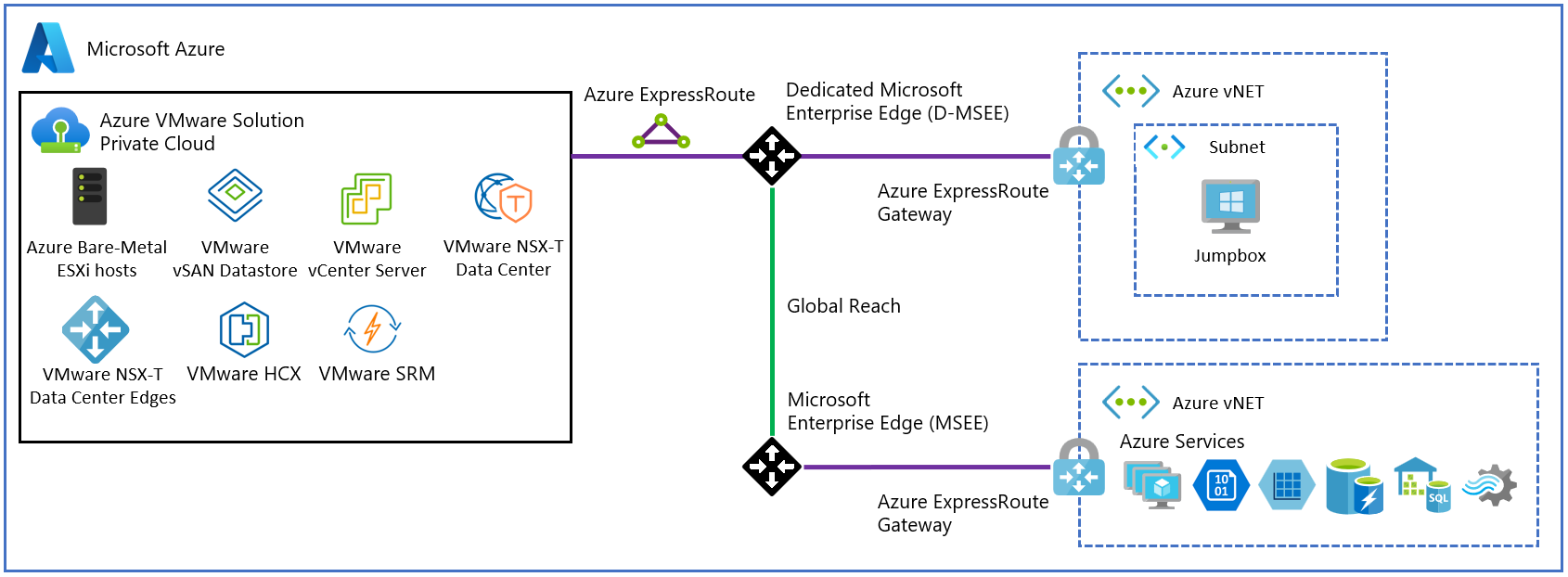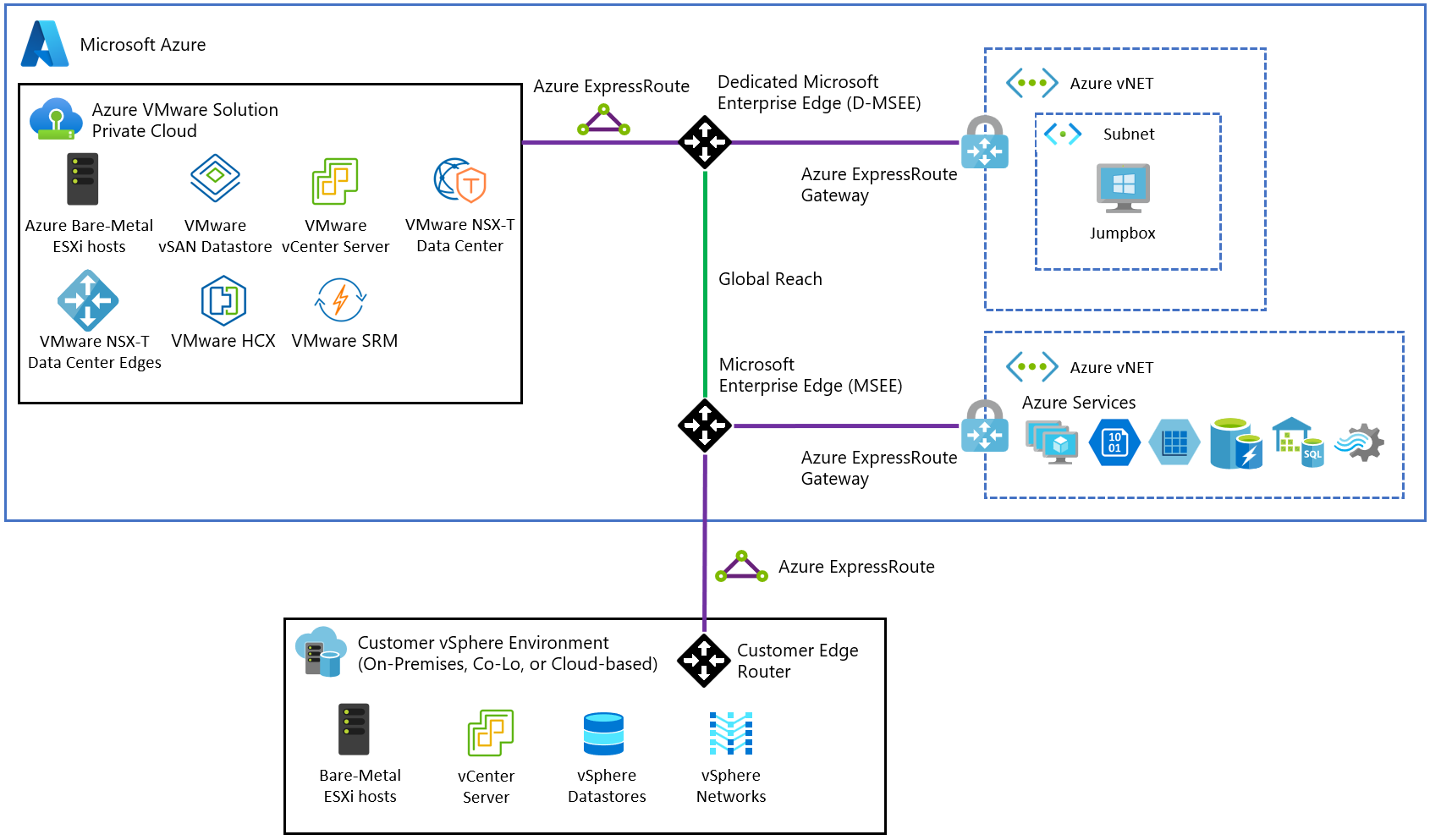Azure VMware Solution networking and interconnectivity concepts
Azure VMware Solution offers a private cloud environment accessible from on-premises sites and Azure-based resources. Services such as Azure ExpressRoute, VPN connections, or Azure Virtual WAN deliver the connectivity. However, these services require specific network address ranges and firewall ports for enabling the services.
When you deploy a private cloud, private networks for management, provisioning, and vMotion get created. You use these private networks to access VMware vCenter Server and VMware NSX-T Data Center NSX-T Manager and virtual machine vMotion or deployment.
ExpressRoute Global Reach is used to connect private clouds to on-premises environments. It connects circuits directly at the Microsoft Edge level. The connection requires a virtual network (vNet) with an ExpressRoute circuit to on-premises in your subscription. The reason is that vNet gateways (ExpressRoute Gateways) can't transit traffic, which means you can attach two circuits to the same gateway, but it doesn't send the traffic from one circuit to the other.
Each Azure VMware Solution environment is its own ExpressRoute region (its own virtual MSEE device), which lets you connect Global Reach to the 'local' peering location. It allows you to connect multiple Azure VMware Solution instances in one region to the same peering location.
Note
For locations where ExpressRoute Global Reach isn't enabled, for example, because of local regulations, you have to build a routing solution using Azure IaaS VMs. For some examples, see Azure Cloud Adoption Framework - Network topology and connectivity for Azure VMware Solution.
Virtual machines deployed on the private cloud are accessible to the internet through the Azure Virtual WAN public IP functionality. For new private clouds, internet access is disabled by default.
Azure VMware Solution private cloud offers two types of interconnectivity:
Basic Azure-only interconnectivity allows you to manage and use your private cloud with a single virtual network in Azure. This setup is ideal for evaluations or implementations that don't require access from on-premises environments.
Full on-premises to private cloud interconnectivity extends the basic Azure-only implementation to include interconnectivity between on-premises and Azure VMware Solution private clouds.
This article explains key networking and interconnectivity concepts, including requirements and limitations. It also provides the information you need to configure your networking with Azure VMware Solution.
Azure VMware Solution private cloud use cases
The use cases for Azure VMware Solution private clouds include:
- New VMware vSphere VM workloads in the cloud
- VM workload bursting to the cloud (on-premises to Azure VMware Solution only)
- VM workload migration to the cloud (on-premises to Azure VMware Solution only)
- Disaster recovery (Azure VMware Solution to Azure VMware Solution or on-premises to Azure VMware Solution)
- Consumption of Azure services
Tip
All use cases for the Azure VMware Solution service are enabled with on-premises to private cloud connectivity.
Azure virtual network interconnectivity
You can interconnect your Azure virtual network with the Azure VMware Solution private cloud implementation. This connection allows you to manage your Azure VMware Solution private cloud, consume workloads in your private cloud, and access other Azure services.
The following diagram illustrates the basic network interconnectivity established during a private cloud deployment. It shows the logical networking between a virtual network in Azure and a private cloud. This connectivity is established via a backend ExpressRoute that is part of the Azure VMware Solution service. The interconnectivity supports the following primary use cases:
- Inbound access to vCenter Server and NSX Manager from VMs in your Azure subscription.
- Outbound access from VMs on the private cloud to Azure services.
- Inbound access to workloads running in the private cloud.
Important
When connecting production Azure VMware Solution private clouds to an Azure virtual network, use an ExpressRoute virtual network gateway with the Ultra Performance Gateway SKU and enable FastPath to achieve 10Gbps connectivity. For less critical environments, use the Standard or High Performance Gateway SKUs for slower network performance.
Note
If you need to connect more than four Azure VMware Solution private clouds in the same Azure region to the same Azure virtual network, use AVS Interconnect to aggregate private cloud connectivity within the Azure region.
On-premises interconnectivity
In the fully interconnected scenario, you can access the Azure VMware Solution from your Azure virtual network(s) and on-premises. This implementation extends the basic implementation described in the previous section. An ExpressRoute circuit is required to connect from on-premises to your Azure VMware Solution private cloud in Azure.
The following diagram shows the on-premises to private cloud interconnectivity, which enables the following use cases:
- Hot/Cold vSphere vMotion between on-premises and Azure VMware Solution.
- On-premises to Azure VMware Solution private cloud management access.
For full interconnectivity to your private cloud, enable ExpressRoute Global Reach and then request an authorization key and private peering ID for Global Reach in the Azure portal. Use the authorization key and peering ID to establish Global Reach between an ExpressRoute circuit in your subscription and the ExpressRoute circuit for your private cloud. Once linked, the two ExpressRoute circuits route network traffic between your on-premises environments and your private cloud. For more information on the procedures, see the tutorial for creating an ExpressRoute Global Reach peering to a private cloud.
Important
Don't advertise bogon routes over ExpressRoute from on-premises or your Azure VNet. Examples of bogon routes include 0.0.0.0/5 or 192.0.0.0/3.
Route advertisement guidelines to Azure VMware Solution
Follow these guidelines when advertising routes from your on-premises and Azure virtual network to Azure VMware Solution over ExpressRoute:
| Supported | Not supported |
|---|---|
| Default route – 0.0.0.0/0* | Bogon routes. For example: 0.0.0.0/1, 128.0.0.0/1 0.0.0.0/5, or 192.0.0.0/3. |
RFC-1918 address blocks. For example: (10.0.0.0/8, 172.16.0.0/12, 192.168.0.0/16) or its subnets ( 10.1.0.0/16, 172.24.0.0/16, 192.168.1.0/24). |
Special address block reserved by IANA. For example,RFC 6598-100.64.0.0/10 and its subnets. |
| Customer owned public-IP CIDR block or its subnets. |
Note
The customer-advertised default route to Azure VMware Solution can't be used to route back the traffic when the customer accesses Azure VMware Solution management appliances (vCenter Server, NSX Manager, HCX Manager). The customer needs to advertise a more specific route to Azure VMware Solution for that traffic to be routed back.
Limitations
The following table describes the maximum limits for Azure VMware Solution.
| Resource | Limit |
|---|---|
| vSphere clusters per private cloud | 12 |
| Minimum number of ESXi hosts per cluster | 3 (hard-limit) |
| Maximum number of ESXi hosts per cluster | 16 (hard-limit) |
| Maximum number of ESXi hosts per private cloud | 96 |
| Maximum number of vCenter Servers per private cloud | 1 (hard-limit) |
| Maximum number of HCX site pairings | 25 (any edition) |
| Maximum number of HCX service meshes | 10 (any edition) |
| Maximum number of Azure VMware Solution ExpressRoute linked private clouds from a single location to a single Virtual Network Gateway | 4 The virtual network gateway used determines the actual max linked private clouds. For more information, see About ExpressRoute virtual network gateways If you exceed this threshold use Azure VMware Solution Interconnect to aggregate private cloud connectivity within the Azure region. |
| Maximum Azure VMware Solution ExpressRoute port speed | 10 Gbps (use Ultra Performance Gateway SKU with FastPath enabled) The virtual network gateway used determines the actual bandwidth. For more information, see About ExpressRoute virtual network gateways |
| Maximum number of Azure Public IPv4 addresses assigned to NSX-T Data Center | 2,000 |
| Maximum number of Azure VMware Solution Interconnects per private cloud | 10 |
| Maximum number of Azure ExpressRoute Global Reach connections per Azure VMware Solution private cloud | 8 |
| vSAN capacity limits | 75% of total usable (keep 25% available for SLA) |
| VMware Site Recovery Manager - Maximum number of protected Virtual Machines | 3,000 |
| VMware Site Recovery Manager - Maximum number of Virtual Machines per recovery plan | 2,000 |
| VMware Site Recovery Manager - Maximum number of protection groups per recovery plan | 250 |
| VMware Site Recovery Manager - RPO Values | 5 min or higher * (hard-limit) |
| VMware Site Recovery Manager - Maximum number of virtual machines per protection group | 500 |
| VMware Site Recovery Manager - Maximum number of recovery plans | 250 |
* For information about Recovery Point Objective (RPO) lower than 15 minutes, see How the 5 Minute Recovery Point Objective Works in the vSphere Replication Administration guide.
For other VMware-specific limits, use the VMware configuration maximum tool.
Next steps
Now that you understand Azure VMware Solution network and interconnectivity concepts, consider learning about:
Feedback
Coming soon: Throughout 2024 we will be phasing out GitHub Issues as the feedback mechanism for content and replacing it with a new feedback system. For more information see: https://aka.ms/ContentUserFeedback.
Submit and view feedback for

